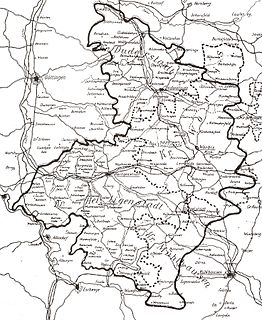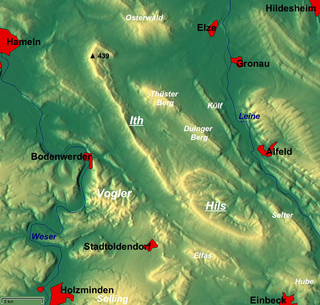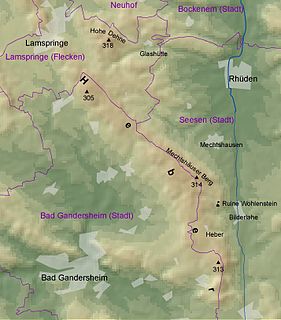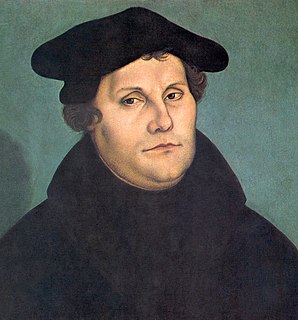
Wittenberg, officially Lutherstadt Wittenberg, is a town in Saxony-Anhalt, Germany. Wittenberg is situated on the River Elbe, 60 kilometers (37 mi) north of Leipzig and 90 kilometers (56 mi) south-west of Berlin, and has a population of 48,501 (2008).

Landkreis Emsland is a district in Lower Saxony, Germany named after the river Ems. It is bounded by the districts of Leer, Cloppenburg and Osnabrück, the state of North Rhine-Westphalia, the district of Bentheim in Lower Saxony, and the Netherlands.
Hildesheim is a district (Landkreis) in Lower Saxony, Germany. It is bounded by the districts of Hanover, Peine, Wolfenbüttel, Goslar, Northeim, Holzminden and Hamelin-Pyrmont.

Holzminden is a district in Lower Saxony, Germany. It is bounded by the districts of Hamelin-Pyrmont, Hildesheim and Northeim, and by the state of North Rhine-Westphalia.
Northeim is a district in Lower Saxony, Germany. It is bounded by the districts of Holzminden, Hildesheim, Goslar and Göttingen, and the state of Hesse.
Göttingen is a district in Lower Saxony, Germany. It is bounded by the districts of Northeim and Goslar, and by the states of Thuringia and Hesse.

Goslar is a district in Lower Saxony, Germany. It is bounded by the districts of Göttingen, Northeim, Hildesheim and Wolfenbüttel, the city of Salzgitter, and by the states of Saxony-Anhalt and Thuringia (Nordhausen).
Osterode was a district in Lower Saxony, Germany. It was bounded by the districts of Göttingen, Northeim and Goslar, and by the state of Thuringia.

Höxter is a Kreis (district) in the east of North Rhine-Westphalia, Germany. Neighboring districts are Holzminden, Northeim, Kassel, Waldeck-Frankenberg, Hochsauerland, Paderborn, and Lippe.
Stendal is a district (Landkreis) in the north-east of Saxony-Anhalt, Germany. Its neighbouring districts are : Jerichower Land, Börde, Altmarkkreis Salzwedel, Lüchow-Dannenberg in Lower Saxony, and the districts of Prignitz, Ostprignitz-Ruppin and Havelland in Brandenburg.

Gubin is a town in Krosno Odrzańskie County, Lubusz Voivodeship, in southwestern Poland. It is the administrative seat of the rural Gmina Gubin, though not part of it.

The Eichsfeld is a historical region in the southeast of the state of Lower Saxony and northwest of the state of Thuringia in the south of the Harz mountains in Germany. Until 1803 the Eichsfeld was for centuries part of the Archbishopric of Mainz, which is the cause of its current position as a Catholic enclave in the predominantly Protestant north of Germany. Following German partition in 1945, the West German portion became Landkreis Duderstadt. A few small transfers of territory between the American and Soviet zones of occupation took place in accordance with the Wanfried Agreement.

Camenca is a town in Transnistria, Moldova. It is composed of the town itself, and the village of Solnecinoe. Camenca is the seat of Camenca District.

Susz is a town in Iława County, Warmian-Masurian Voivodeship, Poland, with 5,600 inhabitants (2004).

Zabór is a village in Zielona Góra County, Lubusz Voivodeship, in western Poland. It is the seat of the gmina called Gmina Zabór. It lies approximately 15 km (9 mi) east of Zielona Góra.
Echte is a village in the Gemeinde Kalefeld in the district of Northeim in northern Germany with about 1,380 inhabitants.

The Hils is a range of hills in Germany's Central Uplands that is up to 480.4 m high. It is located in the districts of Holzminden, Hildesheim and Northeim, in the state of Lower Saxony.
Mackensen is a village of about 450 inhabitants which is incorporated into the city of Dassel since 1974.

The Heber is a hogback ridge, relatively small in area and up to 313.5 metres high, in the Lower Saxon Hills within the districts of Goslar, Northeim and Hildesheim in the German state of Lower Saxony.


















